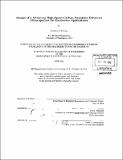Design of a miniature high-speed carbon-nanotube-enhanced ultracapacitor for electronics applications
Author(s)
D'Asaro, Matthew E. (Matthew Eric)
DownloadFull printable version (14.11Mb)
Other Contributors
Massachusetts Institute of Technology. Dept. of Electrical Engineering and Computer Science.
Advisor
Joel E. Schindall.
Terms of use
Metadata
Show full item recordAbstract
Electrolytic capacitors, the current standard for high-value capacitors, are one of the most challenging components to miniaturize, accounting for up to 1/3 of the volume in some power devices, and are the weak link with regard to reliability, accounting for the majority of failures in consumer electronics. As a potential alternative vertically aligned carbon nanotubes are utilized to create miniature high-speed ultracapacitors. Because the nanotubes are grown on silicon using low pressure chemical vapor deposition, this technique also opens the possibility of high-value integrated (on-die) capacitors. Using this technique a capacitance density of 52 [mu]F/mm2 was achieved. Separately, through careful design of the electrode geometry it is demonstrated that the ionic resistance, the primary factor responsible for the long time constant of ultracapacitors, scales approximately linearly with electrode finger width, thereby demonstrating a workable method for making miniature high-speed ultracapacitors. This work represents the first known example of controlling an ultracapacitor time constant purely though modification of the mechanical structure of the electrodes. It is further projected that using advanced lithography and growth techniques this speed could be increased to 120 Hz. Finally, a variety of packaging techniques are examined for both integrated and discrete applications of this technology.
Description
Thesis (S.M.)--Massachusetts Institute of Technology, Dept. of Electrical Engineering and Computer Science, 2012. Cataloged from PDF version of thesis. Includes bibliographical references (p. 67-68).
Date issued
2012Department
Massachusetts Institute of Technology. Department of Electrical Engineering and Computer SciencePublisher
Massachusetts Institute of Technology
Keywords
Electrical Engineering and Computer Science.